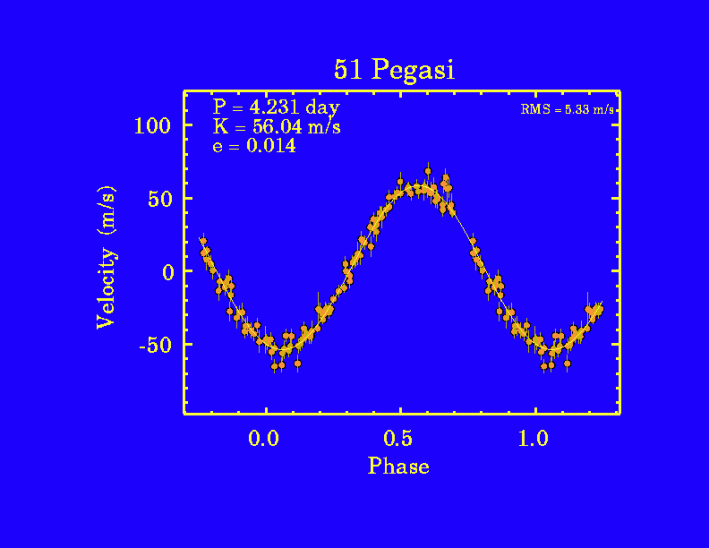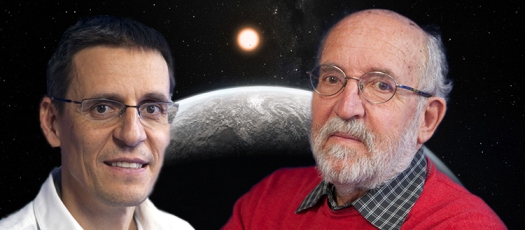
Given the complex history of the discovery and announcement in 1995 of the first exoplanet that orbits a sun-like star, it is perhaps no surprise that errors might sneak into the retelling. Two main groups were racing to be first, and for a variety of reasons the discovery ended up being confirmed before it was formally announced.
A confusing situation prone to mistakes if all involved aren’t entirely conversant with the details. But an error — tantamount to scientific plagiarism — by the Nobel Committee? That is a surprise.
The faux pas occurred at the announcement on October 8 that Michel Mayor of the University of Geneva and Didier Queloz of the the University of Cambridge had won the Nobel for physics to honor their work in detecting that first exoplanet orbiting a sun-like star.
As Nobel Committee member Ulf Danielsson described the achievement, a powerpoint display of important moments and scientific findings in their quest was displayed on a screen behind him.
When the ultimate image was on deck to be shown — an image that presented the Doppler velocity curve that was described as the key to the discovery — the speaker appeared to hesitate after looking down to see what was coming next.
If he did hesitate, it was perhaps because to those in the know, the curve did not come from Mayor and Queloz.
Rather, it was the work of a team led by Geoffrey Marcy and Paul Butler — the San Francisco State University group that confirmed the existence of the hot Jupiter exoplanet 51 Pegasi b several days after the discovery was made public (to some considerable controversy) at a stellar systems conference in Florence. So at a most significant juncture of the Nobel introduction of the great work of Mayor and Queloz, hard-won data by a different team was presented as part of the duo’s achievement.
This is both awkward and embarrassing, but it also indirectly points to one of the realities that the Nobel Committee is forced, by the will of Alfred Nobel, to ignore: That science is seldom the work now of but two or three people.
The Nobel Committee can award only three Nobels per category, but the scientific advances that led to the Mayor-Queloz discovery were part of a much larger enterprise, as is the case with most major science advances. And what began in the mid 1990s with 51 Pegasi b has blossomed spectacularly with the ingenuity and hard work of thousands of other exoplanet scientists.

Why does this faux pas matter?
One reason, in my view, is that the contribution of the American team has at times gotten quite lost in the telling of the 51 Pegasi b story. Their work is mentioned in the Nobel citation for sure, but that is pretty thin gruel. (The race between the Swiss and American teams to find the first exoplanet orbiting a sun-like star is described in a Many Worlds column written soon after the Mayor/Queloz Nobel was announced.)
There are many reasons for this. One for sure is that in 2015 the high-profile Marcy was booted out of the University of California, Berkeley astronomy department and off prestigious boards and scientific collaborations because of numerous accusations of sexual harassment during his career determined to be well-founded.
Some ten years before that happened, Butler, as well as master spectrometer builder Steven Vogt and others from their original team, had broken bitterly with Marcy over different issues. Butler was already a staff scientist at the Carnegie Institution for Science in Washington, from which year after year he has traveled to Chile, Hawaii, Australia and more to spend his nights searching for more planets. He has found hundreds of them (with colleagues, of course) and has worked with promising young astronomers to make some of the major exoplanet discoveries of the 2010s.
Several years ago, Butler wrote the history of his early days as a planet hunter, with a detailed description of the science (and drama) of the first discovery and confirmation. Is was published on the Pale Red Dot website set up by astronomer Guillem Anglada-Escudé, who in recent years played a leading role on the teams that found the two exoplanets closest to Earth — Proxima Centauri b and Barnard’s star. Butler is a co-author on both of those papers.
https://palereddot.org/a-brief-personal-history-of-exoplanets-by-paul-butler/
If you look at the Pale Red Dot article, you will see well into the text a key graph that Butler and Marcy produced to confirm the initial Mayor/Queloz discovery. This is the graph:

In full disclosure, I have written in the past about Butler’s work and I consider him to be a friend. But he is not the one who identified this Nobel misidentification. (Butler later wrote to me from the Las Campanas Observatory in Chile that the Nobel announcement had nothing to do with him and so he knew nothing about it.)
It was rather another member of that original Bay area group, then doctoral student and now San Francisco State University adjunct assistant professor of astronomy and physics Chris McCarthy, who noticed the misidentification. He had seen the video of the Nobel announcement and saw what seemed to be a very familiar graph displayed during the presentation.
When I contacted him, this is what McCarthy wrote to me:
“In fact, these data were not obtained by those who received the prize but by Marcy & Butler at Lick Observatory. I know this because this image has the format that all our data plots had in those days, with the best fitting values for P,K and e in the upper left with the RMS scatter in the upper right…”
He sent this link to an article posted on the then brand-new Worldwide Web in the aftermath of the 51 Pegasi b discovery: http://exoplanets.org/no51pegb.html
The graph is present on the link, which includes a description of how Marcy and Butler teamed up with Mayor and Queloz to fight back against broad scientific critiques of their respective team’s exoplanet work at that time.
“Ironically,” McCarthy wrote, “the problem of misappropriation of data happened early on, and after the image shown above first began to be credited to Michel & Didier. Thereafter all subsequent public data images were tagged with ‘Marcy & Butler’ on the image to avoid this confusion. But somehow this first, unlabeled image has remained around all these years to be misidentified again.”
The graph is definitely not from the Swiss team, he wrote. “All their graphs were black & white back then with the Greek letter φ for phase as the x-axis label.”

“For many years I have wondered how the Nobels would handle exoplanets. If the goal is to recognize contributions to the field then the award should clearly go to Geoff and Paul (who found 70% of the first hundred planets) as well as Mayor & Queloz. However Nobels can only go to three people, max, according to Alfred Nobel’s will. Up until 2015 I thought the award would go to Geoff & Michael. However, at this point in time, it would be hard for the Nobels to recognize Geoff without sending a clear message condoning sexual harassment. In principle, they could have included Paul as the 3rd person.”
“They seem to have narrowed the usual scope from rewarding large contributions to a field of research to rewarding one single discovery….one paper. That’s very unusual for the Nobels but it does give them a way to recognize the importance of exoplanet research.”
I contacted the Nobel Committee for comment about the graph mixup and Mats Larsson, Chair of the Nobel Committee for Physics wrote back to say that the radial velocity curve used in the press conference was indeed Marcy and Butler’s, and he explained the convoluted path of how it got there. He wrote that “By mistake, the (Marcy/Butler) radial velocity graph made its way into the press conference, which is unfortunate.”
It was unfortunate, but it also reflects the reality that prizes to individuals in high-profile science tend to distort what actually happened. Not only are there supporting team members often making essential contributions, but there is also a scientific backdrop that informs, inspires and leads the field forward.
And taking the argument a step further, there’s a burgeoning community of exoplanet scientists that, since the discovery of 51 Pegasi b, has advanced the field at warp speed. Mayor and Queloz deserve to be honored for sure, but it’s the larger community that has done something remarkable.
